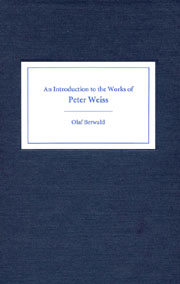Book contents
- Frontmatter
- Contents
- Acknowledgments
- Introduction
- 1 Subversive Slapstick: The Early Plays Der Turm, Die Versicherung, Nacht mit Gästen, and Mockinpott
- 2 The Choreography of Documents: Die Ermittlung, Gesang vom Lusitanischen Popanz, and Viet Nam Diskurs
- 3 Staging Writers as Outcasts: Marat/Sade, Trotzki im Exil, Hölderlin, Der Prozess, and Der neue Prozess
- 4 Scenarios of Stagnation: Early Prose
- 5 Autobiography and Fiction: Abschied von den Eltern, Fluchtpunkt, and Rekonvaleszenz
- 6 Poetics and Politics: Essays, Open Letters, and Fragments
- 7 Perception as Resistance: Die Ästhetik des Widerstands
- Works Consulted
- Index
1 - Subversive Slapstick: The Early Plays Der Turm, Die Versicherung, Nacht mit Gästen, and Mockinpott
Published online by Cambridge University Press: 05 February 2013
- Frontmatter
- Contents
- Acknowledgments
- Introduction
- 1 Subversive Slapstick: The Early Plays Der Turm, Die Versicherung, Nacht mit Gästen, and Mockinpott
- 2 The Choreography of Documents: Die Ermittlung, Gesang vom Lusitanischen Popanz, and Viet Nam Diskurs
- 3 Staging Writers as Outcasts: Marat/Sade, Trotzki im Exil, Hölderlin, Der Prozess, and Der neue Prozess
- 4 Scenarios of Stagnation: Early Prose
- 5 Autobiography and Fiction: Abschied von den Eltern, Fluchtpunkt, and Rekonvaleszenz
- 6 Poetics and Politics: Essays, Open Letters, and Fragments
- 7 Perception as Resistance: Die Ästhetik des Widerstands
- Works Consulted
- Index
Summary
Der Turm, Peter Weiss's first drama, was written in 1948 and premiered in a Swedish version on a small stage in Stockholm two years later. In the German-speaking countries, it first appeared as a radio play in 1962, before its first production, directed by Irimbert Ganser, took place in Vienna in 1967. Detlef Heusinger's opera Der Turm (1988), whose libretto is based upon Weiss's play, premiered in Bremen in 1989.
The topos of the tower as a scenic construction of painful passivity has a long literary history, including Calderón de la Barca's “comedia seria” La vida es sueño (1630) and Hugo von Hofmannsthal's drama Der Turm (1923–1928). Weiss's Turm displays strong thematic and stylistic affinities to German romanticism as well as to August Strindberg's dramas and Hermann Hesse's works. The play implies but never fully reveals a preceding story of a young man's imprisonment and desperate outbreak.
Pablo, the protagonist of Weiss's Der Turm, lived and worked in the tower of a circus company in his childhood, where he was kept against his will and forced to perform balancing acts. He returns to the tower to overcome his fear of his past by reenacting it rather than by running away from it (13). In his prologue to the radio play version, Weiss highlights the necessity for Pablo to work through his traumatic past in a detached manner to overcome it.
- Type
- Chapter
- Information
- An Introduction to the Works of Peter Weiss , pp. 11 - 21Publisher: Boydell & BrewerPrint publication year: 2003



